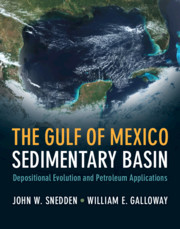Book contents
- The Gulf of Mexico Sedimentary Basin
- The Gulf of Mexico Sedimentary Basin
- Copyright page
- Dedication
- Contents
- Preface
- Abbreviations
- Part I Introduction
- Part II Mesozoic Depositional Evolution
- Chapter 2 Post-Orogenic Successor Basin-Fill and Rifting Phase
- Chapter 3 Middle Mesozoic Drift and Cooling Phase
- Chapter 4 Late Mesozoic Local Tectonic and Crustal Heating Phase
- Part III Cenozoic Depositional Evolution
- Part IV Petroleum Habitat
- Glossary
- References
- Index
Chapter 4 - Late Mesozoic Local Tectonic and Crustal Heating Phase
from Part II - Mesozoic Depositional Evolution
Published online by Cambridge University Press: 13 September 2019
- The Gulf of Mexico Sedimentary Basin
- The Gulf of Mexico Sedimentary Basin
- Copyright page
- Dedication
- Contents
- Preface
- Abbreviations
- Part I Introduction
- Part II Mesozoic Depositional Evolution
- Chapter 2 Post-Orogenic Successor Basin-Fill and Rifting Phase
- Chapter 3 Middle Mesozoic Drift and Cooling Phase
- Chapter 4 Late Mesozoic Local Tectonic and Crustal Heating Phase
- Part III Cenozoic Depositional Evolution
- Part IV Petroleum Habitat
- Glossary
- References
- Index
Summary
The Late Mesozoic Local Tectonic and Crustal Heating Phase follows the end of sea floor spreading and is marked by local tectonic uplifts, beginning with a major Early Cretaceous siliciclastic influx in the eastern Gulf of Mexico, likely from uplift of the Peninsular Arch, as indicated by detrital zircon geochronology of the Hosston Sandstone. The younger Tuscaloosa Sandstone marks the first major entry of siliciclastics into the central northern Gulf deepwater basin in the Ceno-Turonian. The Eagle Ford Shale, a world-class unconventional play, forms in restricted shelf basins in south Texas. A reduction of siliciclastic input, combined with globally high sea level results in pervasive deep marine sedimentation culminating in chalk deposition in the latest Cretaceous. The end of Mesozoic Chicxulub impact event generated mass transport deposits, breccia, and hybrid flows related to seismic shaking and catastrophic slope failures, greatly modifying the land- and seascape of the basin and paving the way for long-lived source-to-sink transport systems routing sediment from the Laramide orogenic belt into the deep Gulf basin.
Keywords
- Type
- Chapter
- Information
- The Gulf of Mexico Sedimentary BasinDepositional Evolution and Petroleum Applications, pp. 101 - 164Publisher: Cambridge University PressPrint publication year: 2019



